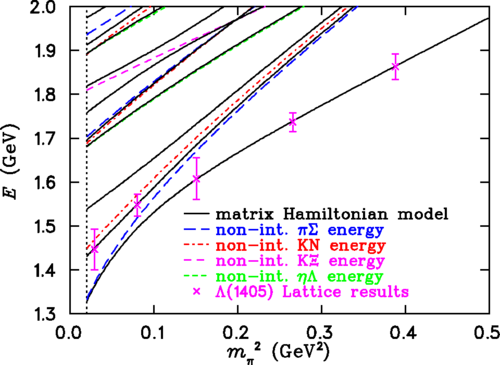April 6, 2015 report
Supercomputer study shows Lambda baryon a type of quark molecule

(Phys.org)—A team of researchers with the University of Adelaide and the Australian National University has found that the excited state of the Lambda baryon, Λ(1405), is actually a type of quark molecule. In their paper published in the journal Physical Review Letters, the researchers describe how they ran simulations on a computer that confirmed the properties of the unique particles.
Scientists have learned over the years that subatomic particles can link or bond together in ways that are similar to atoms in molecules. One such particle Λ(1405) has been the focus of much research and discussion among physicists as it has defied the description of a typical baryon (a subatomic particle with a mass greater than or equal to a proton and which exist as a nucleon or hyperon)—they are supposed to have three quarks. Instead, they have shown behavior that suggests a molecule-like structure consisting of a quark pair and a triplet—prior research has shown that it takes less energy to cause it to be excited than should be the case for three quarks bound together, suggesting that there is something else at play, such as extra quarks. The apparent oddity has had physicists debating its nature for over half a century.
Particles that have quarks are typically divided into two categories, two-quark mesons and three-quark baryons. Some researchers in the past had theorized that Λ(1405) particles could be actually be a combination of mesons and baryons which would result in a particle "molecule" with five quarks. In this new study, the researchers ran simulations of quark interactions (using algorithms based on lattice quantum chromodynamics) on a supercomputer that appears to confirm that theory—they found a magnetic moment of zero when calculating the quark contribution to the particle, which suggested instances of a meson (antikaon) coupled to a baryon—the first such example of a meson-baryon molecule.
The research by the team builds on the efforts of others who have recently suggested other types of couplings (such as two mesons) might occur. The researchers believe further research will reveal other meson-baryon pairings as well that until now have been thought to be unique types of baryons.
More information: Lattice QCD Evidence that the Λ(1405) Resonance is an Antikaon-Nucleon Molecule, Phys. Rev. Lett. 114, 132002 – Published 1 April 2015. dx.doi.org/10.1103/PhysRevLett.114.132002 . On Arxiv: arxiv.org/abs/1411.3402
ABSTRACT
For almost 50 years the structure of the Λ(1405) resonance has been a mystery. Even though it contains a heavy strange quark and has odd parity, its mass is lower than any other excited spin-1/2 baryon. Dalitz and co-workers speculated that it might be a molecular state of an antikaon bound to a nucleon. However, a standard quark-model structure is also admissible. Although the intervening years have seen considerable effort, there has been no convincing resolution. Here we present a new lattice QCD simulation showing that the strange magnetic form factor of the Λ(1405) vanishes, signaling the formation of an antikaon-nucleon molecule. Together with a Hamiltonian effective-field-theory model analysis of the lattice QCD energy levels, this strongly suggests that the structure is dominated by a bound antikaon-nucleon component. This result clarifies that not all states occurring in nature can be described within a simple quark model framework and points to the existence of exotic molecular meson-nucleon bound states.
Journal information: arXiv , Physical Review Letters
© 2015 Phys.org





















